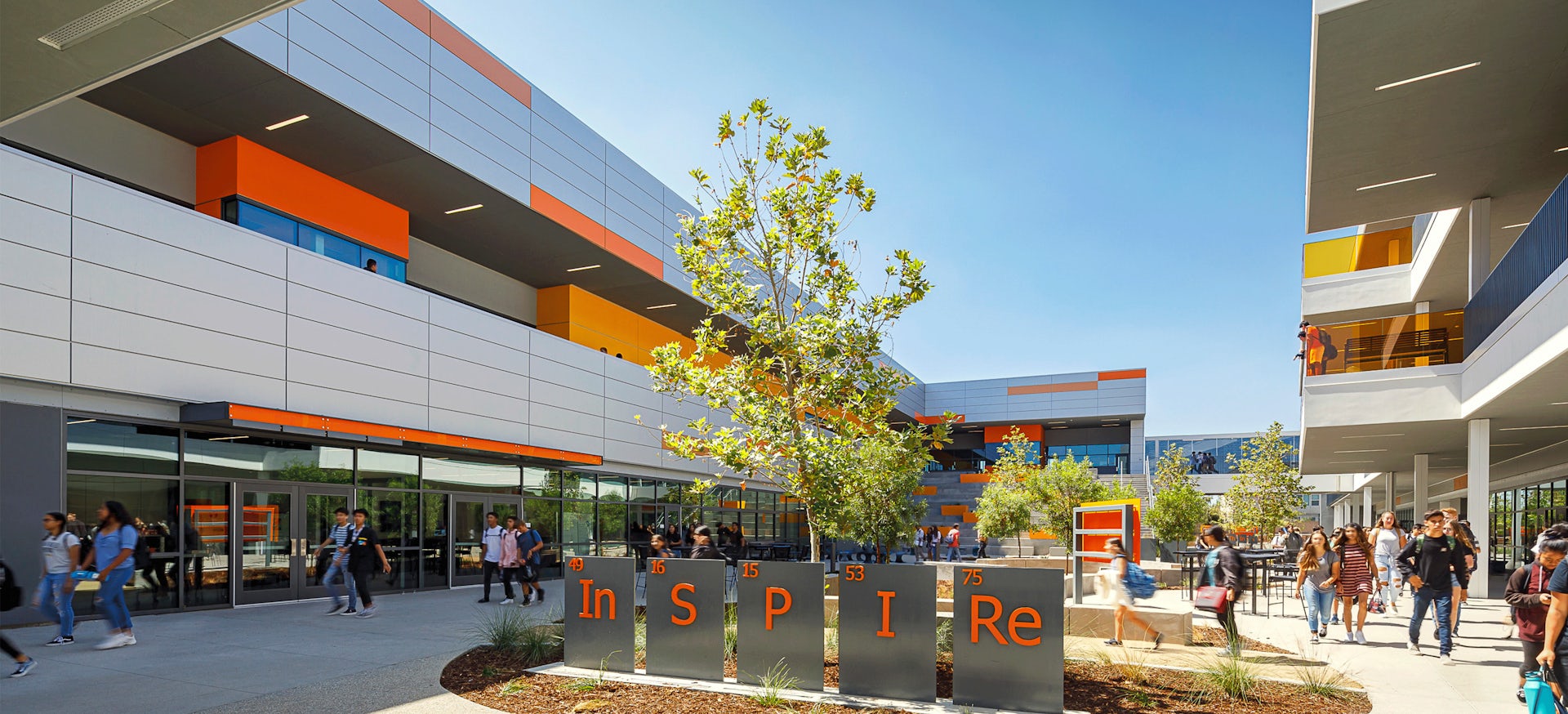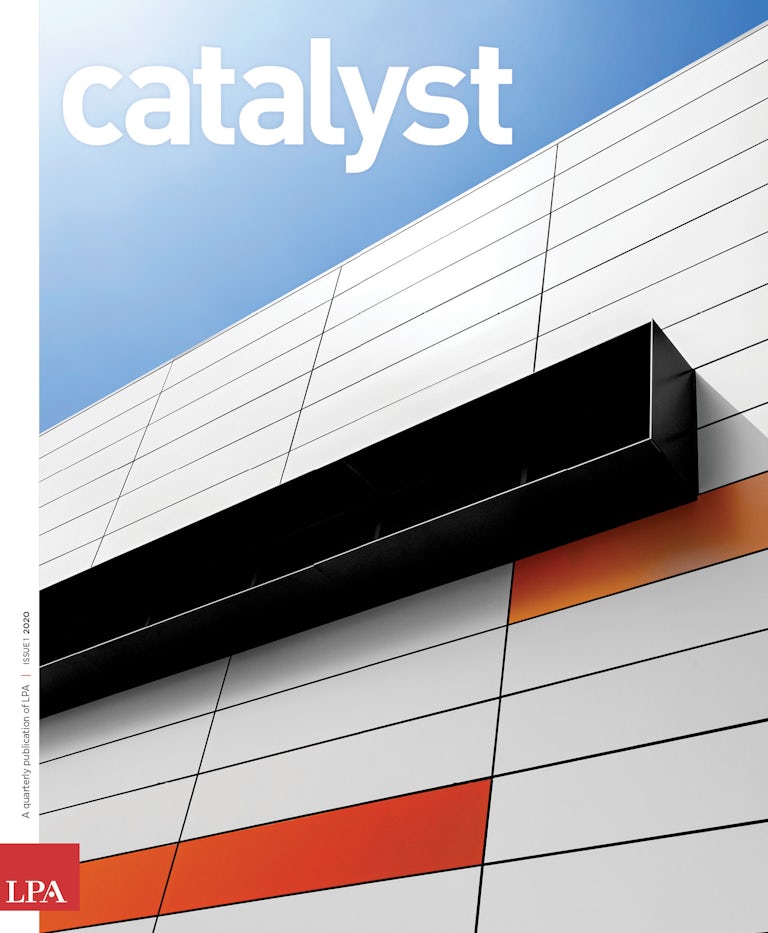In the new state-of-the-art, three-story Eastvale STEM Academy, “Spark Tanks” are sprinkled throughout the campus, offering intimate spaces where students can explore new ideas.
“The Spark Tanks are about inspiration and getting students excited about learning,” says LPA Managing Director David Eaves.
The Academy, known as “eSTEM,” opened last year on the campus of Eleanor Roosevelt High School, a fast-growing school with more than 4,000 students in the Corona-Norco Unified School District, 45 miles southeast of Los Angeles. Designed around an open courtyard, eSTEM is a multi-layered series of connected colabs and flexible learning environments, where learners can solve problems in bright, vibrant environments that promote creative thinking.
The design process started with an extensive engagement process with educators, students and the community. Local businesses and universities were included in the discussions to develop a clearer outlook for career paths and opportunities for collaboration. “The eSTEM Advisory Committee worked with LPA architects and began profiling what a 21st century learner looked like,” says Kim Lu Lawe, Director of eSTEM. “We saw a future-ready student who had the skills to collaborate and communicate effectively with others.”
Preparing Students for the Real World
The design for the Eastvale STEM Academy provides labs and specialized learning spaces that reflect the goals of educators and the community.

The district decided to focus the Academy on preparing students for careers in the health/medical and design/engineering professions. Labs on the ground floor focus on professional settings, with specialized environments designed to support bio-medical technology, healthcare and engineering pathways. In the health labs, students work with real hospital beds, blood draw chairs, virtual cadavers and other equipment to support specific skills.
The eSTEM campus occupies a three-acre site that provides a unique identity for the academy, as well as direct access to the existing campus. To maximize outdoor learning spaces and create a buffer between the campus and nearby the residences, the facility was condensed into a three stories and the program was divided into two buildings, to maintain the visual and pedestrian connection with the rest of the campus.

In my 15 years as a teacher, I have never seen such a positive energy in the classroom and around the campus. Several teachers, including myself, have opened up the retractable walls and collaborated with the teacher in the adjoining room. - Scott Usher, eSTEM computer science teacher

A three-month engagement process focused the design effort on the health/medical and design/engineering professions, reflecting the area’s employment opportunities. During the programming phase, LPA architects, landscape architects, interior designers and education team met regularly with educators and the community to define the school’s learner profile, which informed the design guidelines. Subcommittees were formed to focus on different areas, including the challenges of integrating the new 850-student STEM campus with the existing school and an exploration of how the built environment would impact the eSTEM students and curriculum.
LPA enlisted the help of Wayfind Education founder and LPA consultant Julie Zoellin Cramer, who helped focus the conversation. “She spoke the language of the teachers, whereas we spoke the language of the built environment,” said Kari Kikuta, LPA’s Director of Landscape Architecture. “She helped develop that common language between the people who would use the spaces and the people who would build them.”
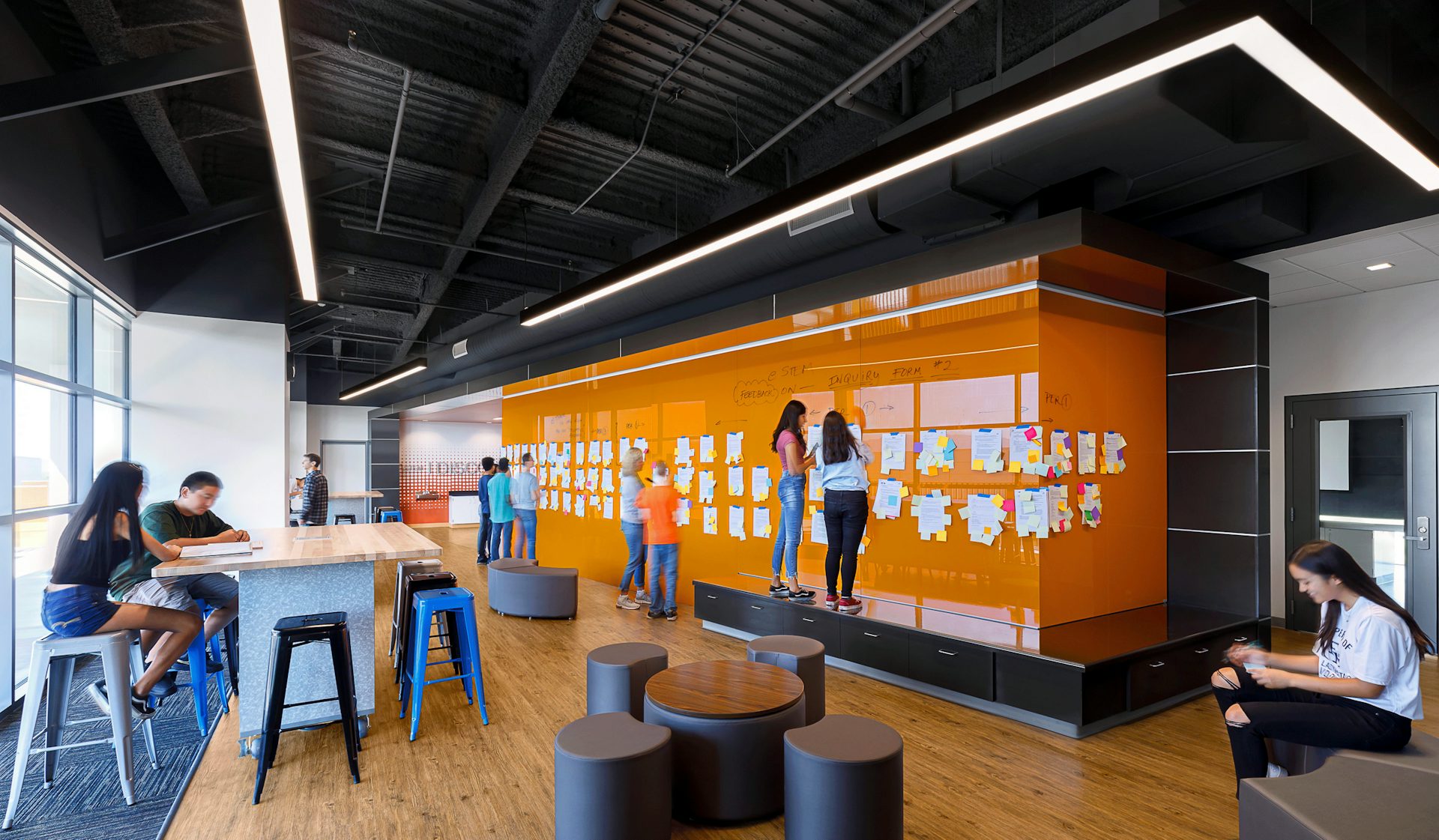
The result of this effort was a team-authored, board-approved Educational Vision Document, which served as the foundation for the design process. The overarching themes established during programming were collaboration, access, partnership and flexibility. To ensure consistency, key members from the planning groups remained intimately involved throughout each phase of design and construction.
“I think it all boiled down to knowledge and trust,” says LPA Project Designer Stephanie Matsuda-Strand. “They understood everything we were saying because we had walked them through every step, and they trusted us.”
The impact of those effects can be found throughout the facility. Learning studios are adaptable and varied to allow for multiple teaching modalities and the ability to evolve with changes in the pedagogy. Labs are connected and zoned largely by furniture, ceiling changes, casework, and partial-height and operable walls.
The combination of numerous, dispersed and varied learning spaces, coupled with visibility and access, encourages learning and collaboration to happen everywhere. Outdoor learning spaces take many forms and can be found on each floor of the three-story campus, including floating learning pods. Glass balconies on the upper levels can be used for classes or experiments. On the ground floor, rollup doors allow teachers and students to easily expand projects into the outdoor spaces, using equipment and desks on wheels. Most areas include writable surfaces. Technology is plug and play and available throughout the complex.

“The idea that technology is everywhere and is accessible everywhere is an important component of these spaces,” Eaves says.
Throughout the campus, there is a sense of fun and exploration. Easter eggs were added to spaces, designed to provoke and inspire thought while generating a strong sense of school identity. The horizontal sunshades mimic a heartbeat on an EKG. The color pattern on the metal panel cladding is inspired by brainwaves measured on an EEG. Glass panels in the entry exhibit binary code that, when deciphered, talk about the school’s dedication to the six Cs of Critical Thinking.
Many elements of the campus evolved as designers worked through details with the teachers and students. During the process, a student union was added. “The more we talked about it, the more we identified the need for some sort of space like what you’d find on a college campus, where during odd hours of the day, students would have an opportunity to access technology and work solo or with friends,” Matsuda-Strand says.
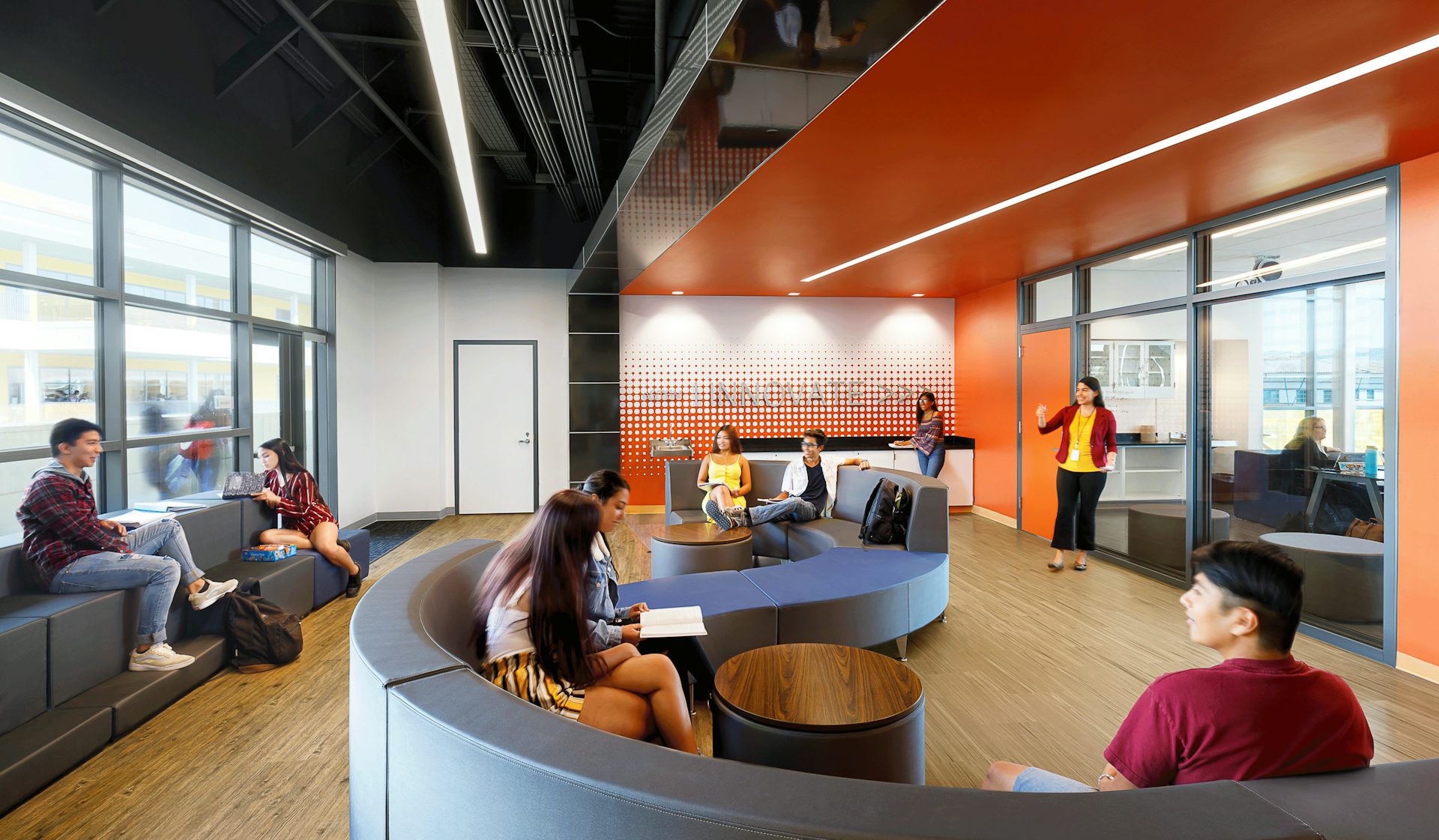
We saw a future-ready student who had the skills to collaborate and communicate effectively with others.
Teachers have already seen the impact eSTEM is having on the students. Hallway and outdoor spaces are used for a variety of hands-on learning projects, diving into everything from carbon capture experiments to research on gene editing. “In my 15 years as a teacher, I have never seen such a positive energy in the classroom and around the campus,” says eSTEM computer science teacher Scott Usher. “Several teachers, including myself, have opened up the retractable walls and collaborated with the teacher in the adjoining room.”
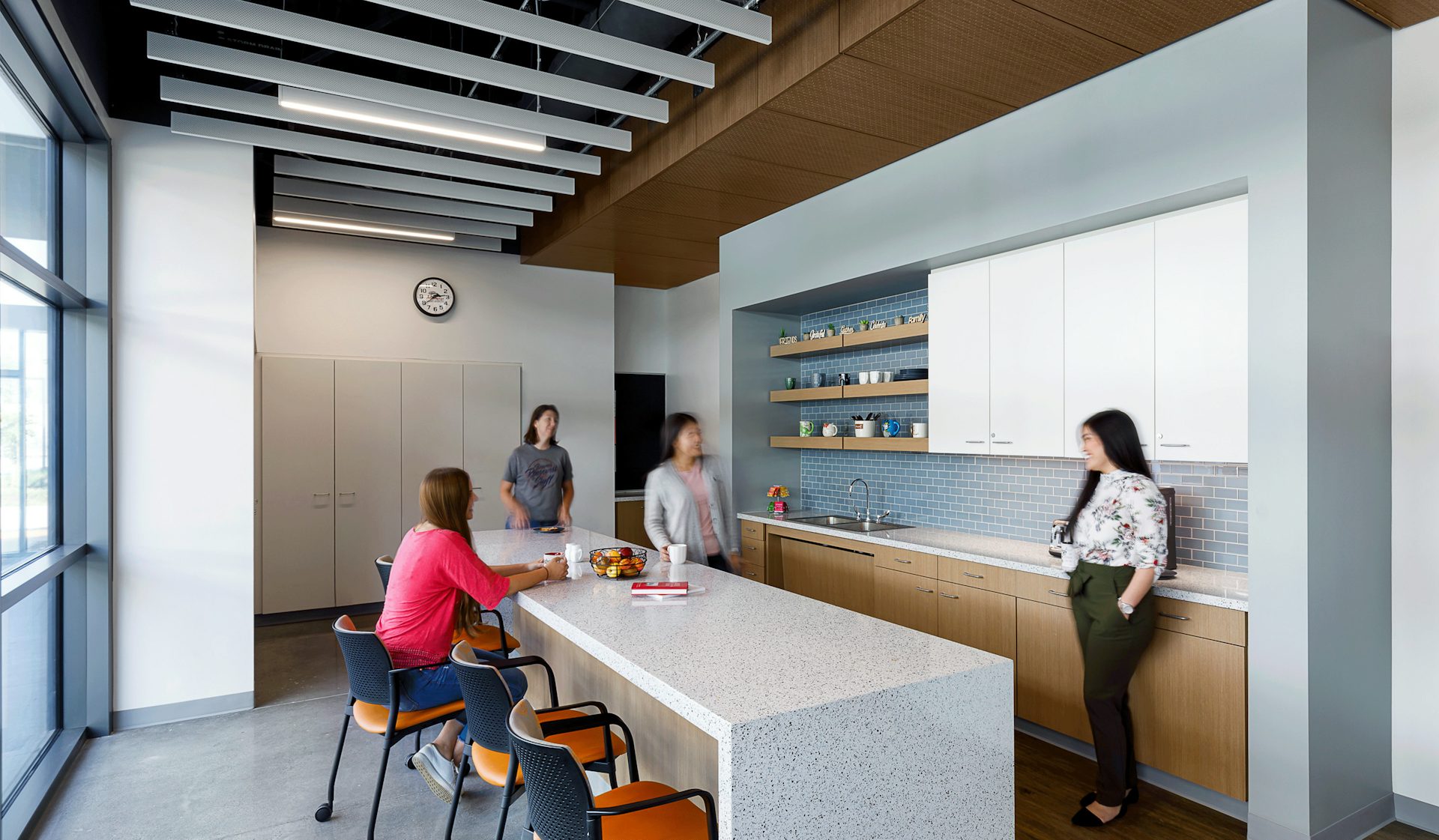
For many people involved, eSTEM has been an especially rewarding experience, as students develop new ways to use the spaces. Throughout the campus, students are engaged in “project-based learning where they are finding solutions to real-world problems,” Lawe says. “All of our teachers and counselors in this building are involved in cross-curricular collaboration to provide opportunities and support for our students to engage in this type of innovative learning.”


